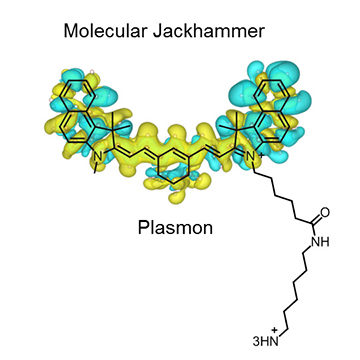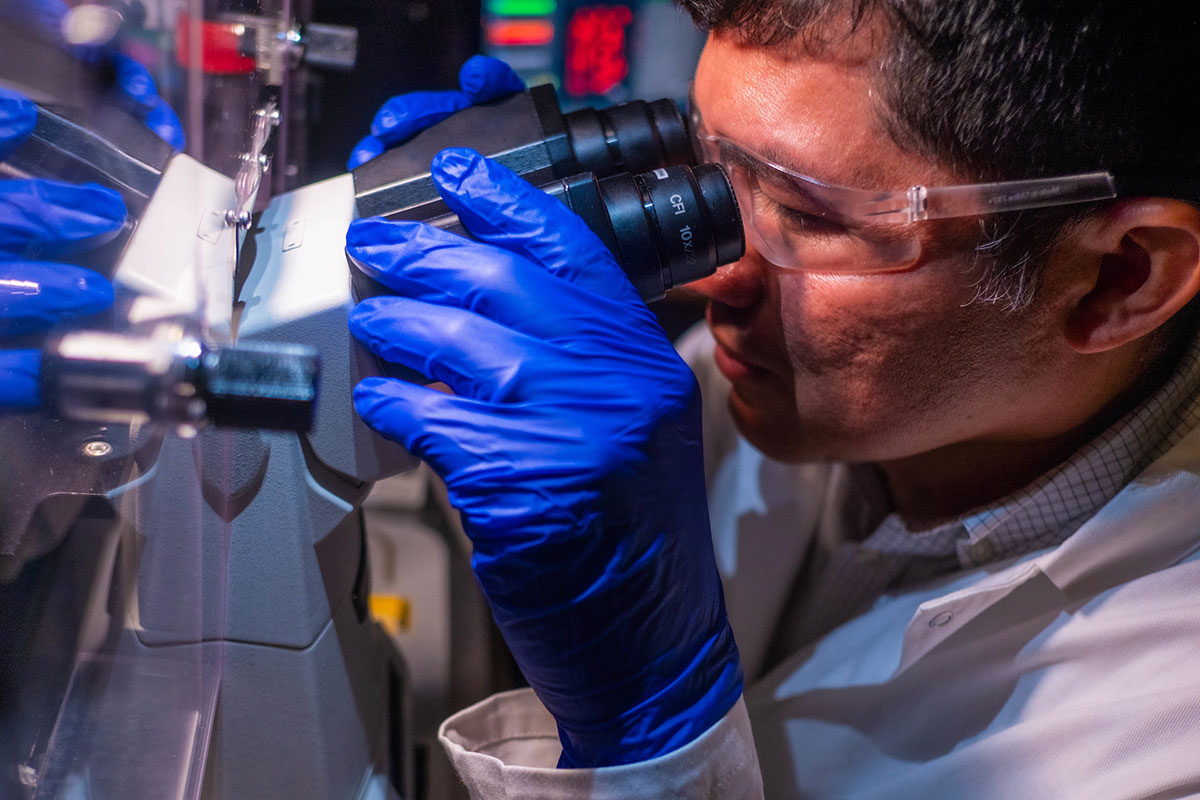Ciceron Ayala-Orozco is lead author of a study showing how molecular “jackhammers,” plasmonically activated by near-infrared light, can tear apart and kill cancerous cells. [Image: Jeff Fitlow / Rice University]
Researchers in the US have shown that cancer cells can be killed by using light to stimulate strong mechanical vibrations in a fluorescent dye that is commonly used for medical imaging (Nat. Chem., doi: 10.1038/s41557-023-01383-y). By rupturing the membrane of the cancer cells, these molecular versions of a jackhammer were shown to destroy 99% of human melanoma cells grown on lab cultures. When used to treat live mice that had human melanoma tumors, half of the 10-strong group were cancer-free after seven months.
Plasmon-induced vibrations
The research team, led by James Tour at Rice University, has previously shown that molecular motors—which have a chain of atoms that can be activated by light to spin continually in the same direction—can be used to drill through the outer membrane of infectious bacteria, cancer cells and treatment-resistant fungi. In this case, however, the light was used to excite plasmons in the small dye molecules, causing all of the atoms in their core molecular structure to vibrate in unison.
This plasmonic approach generates molecular motion on sub-picosecond timescales, more than a million times faster than can be achieved with spinning molecular motors. The collective vibrations can also be also activated using near-infrared light, which penetrates further into the body than the visible frequencies needed to induce motion in other molecular machines. Light at these longer wavelengths can travel 10 cm through biological tissue, compared with just 0.5 cm for visible light.
Leveraging fluorescent dyes
The fluorescent dyes used in this study have a near-symmetrical structure, with an additional arm that helps to anchor them to the membrane of the cancer cells. “These molecules are biocompatible, stable in water, and very good at attaching themselves to the fatty outer lining of cells,” said lead author Ciceron Ayala-Orozco from Rice University. “Due to their structure and chemical properties, the nuclei of these molecules can oscillate in sync when exposed to the right stimulus.”

The molecular-jackhammer molecule includes a long side arm that helps grab onto cancer cells. [Image: Courtesy of Ciceron Ayala-Orozco / Rice University]
Experiments by the team showed that the vibronic modes induced in these molecules could kill cells up to 50 times faster than with photothermal or photodynamic therapies. The method is also effective, the research revealed, with much lower concentrations of dye molecules, and requires less than a tenth of the light intensity to activate the cell-destroying mechanism.
Tearing cancer cells apart
“This is the first time a molecular plasmon has been used to excite the whole molecule and to produce mechanical action that achieves a particular goal—in this case, tearing apart the cancer cells’ membrane,” says Ayala-Orozco. “This study offers a different way to treat cancer by using mechanical forces at the molecular scale.”
The team is now working to identify and synthesize other small molecules that can support these vibronic modes. Potential applications include the selective regulation of active sites in enzymes, the modulation of protein channels and controlling the structure or function of large biological assemblies for use in pharmacology.


